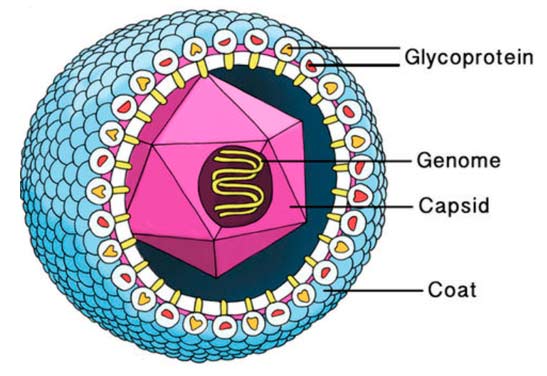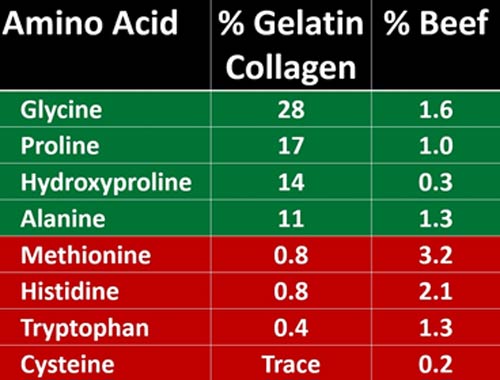How Glycine Fights Viruses
- November 27, 2023
Story at-a-glance
- Collagen accounts for about 30% of the total protein in your body; 28% of collagen, in turn, is made up of the amino acid glycine
- Glycine is the amino acid with the highest concentration in connective tissue. Its benefits go far beyond connective tissue health as glycine has anti-inflammatory effects, acts as a neurotransmitter, and plays an important role in the epigenetic regulation that drives the aging process
- Glycine helps protect against viruses by reinforcing the extracellular matrix, which acts as a physical barrier to infectious agents such as bacteria, fungi and viruses
- Most people need 8.5 to 10 grams more glycine than what their bodies can synthesize in a day
- To boost your glycine intake, either eat more collagen or gelatin-rich foods and take a high-quality collagen or gelatin supplement, or supplement with pure glycine, which is available in powder form and tends to be very affordable
Collagen accounts for about 30% of the total protein in your body; 28% of collagen, in turn, is made up of glycine, and it is the amino acid with the highest concentration in collagen.1 It is a mildly sweet amino acid that can also be used as a sugar substitute.
Glycine, proline and hydroxyproline2 are the raw materials for connective tissue, but the benefits of glycine go far beyond connective tissue health. For example, glycine:
• Has potent anti-inflammatory effects, in part by inhibiting activation of immune cells and suppressing the production of proinflammatory cytokines, and in part by inhibiting the consumption of nicotinamide adenine dinucleotide phosphate hydrogen (NADPH), as detailed in this previous article.
• Plays an important role in the aging process. In some animal studies, diets containing 8% to 12% glycine increased the median lifespan by as much as 28.4%.3
According to previous research,4 glycine may even be responsible for the epigenetic regulation that drives the aging process as a whole. It also induces autophagy, so that renewal and regeneration of your damaged cells can take place.
• Is a precursor to glutathione, a powerful endogenous antioxidant that declines with age.
• Acts as a neurotransmitter5 and may play an important role in depression.6 It’s also been shown to alleviate neuroinflammation and protect against cognitive deficits in mice with neurodegeneration.7
• Helps prevent cancer by inhibiting the growth of blood vessels that feed tumors.8
Glycine Protects Against Viral Infections
Interestingly, glycine also helps protect against viruses by reinforcing your extracellular matrix, as evidenced in a 2021 study.9 Collagen, which is high in glycine, is the primary protein of the extracellular matrix, which acts as a physical barrier against infectious agents such as bacteria, viruses and fungi.
When you’re deficient in glycine, your extracellular matrix is weakened, thereby raising the risk of viruses being able to proliferate through your tissues. Many infectious agents secrete proteases that destroy collagen to facilitate their proliferation.
Some viruses are also known to inhibit collagen synthesis, which has the same effect.10 Making sure you have enough glycine in your system at all times can help prevent viruses from destroying enough collagen to get inside your cells.
Another Mechanism to Explain Glycine’s Infection Protection
A 2020 study11 showed an antiviral mechanism for glycine in that it prevents for formation of capsids. You probably didn’t know this, but viruses carry around an outer shell of proteins called a capsid. This capsid acts like a lockpick in that it attaches to and pries open the cell’s membrane it is seeking to infect.

The virus then hijacks the cell’s inner workings, forcing it to mass produce the virus’s genetic material and construct many viral replicas. These capsids are like popcorn kernels pushing away the lid of an overfilled pot: The new viruses explode through the cell wall, and the cycle continues with more virus lockpicks on the loose.
Since glycine prevents the viruses from forming a capsid, they become unstable and unable to infect other cells as they simply disintegrate without their capsid "shell."

Download this Article Before it Disappears
Download PDFGlycine Supplementation Is a Necessity
While your body does synthesize glycine, there’s a limit to how much your body can make, and more than likely it falls far short of your requirements to perform all of its essential functions. As explained by the authors:12
"Glycine produced by human metabolism is much lower than the cell’s needs, giving a general glycine deficiency of 10 g/day in humans. This effect was tested for three years in 127 volunteers who had virus infections usually once or more times every year.
85 of them took glycine 10 g/day; 42 did not take glycine. Among those who took glycine, only 16 (12 of whom had infections two or more times each year) had the flu just in the first year — but much reduced in severity and duration — while those who did not take glycine, were infected as often and as severely as before.
Glycine intake at the afore-mentioned dose prevents the spread of viruses by strengthening the extracellular matrix barriers against their advance ...
[G]lycine must be considered to be an essential or indispensable amino acid because, although it can be synthesized by human metabolism, the body’s capacity for its synthesis does not satisfy the needs of the cells, especially for collagen synthesis. Neither can glycine be considered ‘conditionally essential’ as its need is a general requisite, independent of any particular circumstances."
According to previous calculations13 that considered glycine’s role in metabolism and the synthesis of metabolites, collagen and other proteins, most people need 8.5 to 10 grams more glycine than what their bodies can make in a day.
As a result, the authors of the 2021 paper recommend daily supplementation at a dose of 10 grams a day "to prevent and solve health problems of the body’s mechanical system such as osteoarthritis and osteoporosis," and "the entire connective system of the extracellular matrix that is found in all tissues."14
"The close relationship we have shown here between the consistency and strength of the extracellular matrix, based on healthy collagen, and resistance to viruses highlights the need to maintain this structure in good condition, for which dietary glycine supplementation is necessary," they note.
The authors also stress that glycine supplementation may be more important than vaccines, because:
"... vaccines are specific for a particular antigen, and continuous mutations of viruses ... can alter their antigenic protein rapidly, rendering the vaccine ineffective in a short time. The enhancement of collagen in the extracellular matrix, however, will always be effective and steadfast against any invasive agent."
The Vitamin C Link
On a side note, the extracellular matrix’s role in blocking infection helps explain why vitamin C is so effective against infections. In short, vitamin C plays a key role in collagen synthesis, so one of the ways in which it prevents and treats infection is by strengthening the extracellular matrix, just like glycine does.
That said, vitamin C alone will not be as effective as when taken in conjunction with glycine. As explained by the authors:15
"Ascorbate contributes to precise collagen synthesis by avoiding or eliminating collateral reactions in proline and lysine hydroxylation, but it cannot cover the need for glycine, which must be ingested additionally to make possible the synthesis and renewal of collagen necessary to maintain firm extracellular matrix."
Glycine With NAC Supports Mitochondrial Health
Another nutrient that has important synergistic effects with glycine is N-acetylcysteine (NAC). Like glycine, NAC is a precursor to glutathione, and when taken together, they can go a long way toward protecting your mitochondrial health.
For example, researchers at Baylor College of Medicine have shown16 that glycine and NAC supplementation not only improves glutathione deficiency but also mitochondrial impairment, oxidative stress and insulin resistance in older mice.
Similar results have also been found in seniors (by the same team). Importantly, in the elderly, supplementation with glycine and NAC improved four of nine hallmarks of aging associated with most age-related disorders, namely mitochondrial dysfunction, inflammation, insulin resistance and genomic damage.
Glycine Protects Against Chronic Disease and Disability
Glycine supplementation makes loads of sense when you consider its role in mitigating chronic disease and disability. As reported in a 2023 scientific review, glycine has been shown to:17
Suppress tumor growth in mice with melanoma18 |
Decrease fasting glucose, insulin, triglyceride and IGF-1 in male rats19 |
Preserve muscle mass and reduce inflammatory markers in mice with cancer cachexia20 |
Improve endothelial function in older rats21 |
Reduce weight gain and improve bone mineral density in a mouse model designed to mimic postmenopausal bone loss22 |
Protect against cardiac hypertrophy23 |
Alleviate neuroinflammation and protect against cognitive deficits in mice with neurodegeneration24 |
Researchers have also noted that supplemental glycine may be useful for the "prevention and control of atherosclerosis, heart failure, angiogenesis associated with cancer or retinal disorders and a range of inflammation-driven syndromes, including metabolic syndrome."25
In his article "Gelatin, Stress, Longevity,"26 the late Ray Peat, a biologist and pioneer of bioenergetic medicine,27 also reviewed a long list of health conditions that can be prevented or alleviated by glycine supplementation and/or increased consumption of collagen or gelatin, including:28
Fibrosis |
Most bleeding problems, including nosebleeds, excessive menstrual bleeding, bleeding ulcers, hemorrhoids and stroke. According to Peat, glycine, taken shortly after a stroke, limits the damage and accelerates recovery |
Epilepsy, by stabilizing nerves and raising the amount of stimulation required to activate nerves |
Multiple sclerosis (MS), thanks to its antispastic effects |
Any condition involving excess prolactin, serotonin and/or cortisol, including autism, postpartum and premenstrual problems, Cushing's disease, diabetes, and impotence |
Muscular dystrophy and myasthenia gravis |
Metabolic disorders29 |
Nonalcoholic fatty liver disease (NAFLD)30 |
Depression and schizophrenia31 |
Other health benefits of glycine include:
- Improved sleep32
- Reduced stress33
- Improved wound healing34
- Improved gut health35
How to Optimize Your Glycine Intake
Considering its many benefits, making sure you get enough glycine in your diet can go a long way toward improving your health and life span, and there are several ways you can do that:
- Eat more collagen or gelatin-rich foods, as glycine makes up nearly one-third of collagen and gelatin. Examples include homemade bone broth made with bones and connective tissue from grass fed, organically raised animals, and chicken broth made from organic chicken feet. The claws are particularly rich in collagen.36
- Take a high-quality collagen or gelatin supplement.
- Take a glycine supplement. Pure glycine is available in powder form and tends to be very affordable and easy to take, as it has a mildly sweet flavor.
Indirectly, animal foods such as seafood, red meat, poultry and dairy products will also raise your glycine level, as these foods contain taurine, which increases glycine.37 That said, don’t rely on red meat for your glycine. As you can see from the chart below, beef contains only a fraction of the glycine you get from gelatin and collagen. You simply cannot get enough glycine from beef alone.

Dosing Suggestions
While there’s no established daily requirement or upper limit of glycine, as previously noted, most people tend to be about 10 grams short of what their bodies need for their daily metabolic processes,38 so that’s probably a good goalpost.
Another study looking at people with metabolic syndrome found 15 grams of glycine a day for three months reduced oxidative stress and improved systolic blood pressure.39
You can’t overdose on glycine, so a daily dose of 10 to 20 grams would probably be an ideal range for most people. If you have any of the chronic health problems reviewed above, or are elderly or frail, you’d probably want to lean toward the higher dosages.
No comments:
Post a Comment